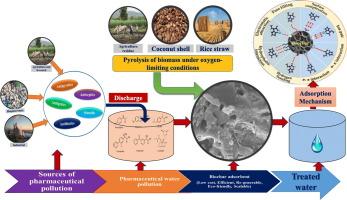缓解废水中药物污染的生物炭:一个可持续的解决方案
IF 8
1区 环境科学与生态学
Q1 ENVIRONMENTAL SCIENCES
引用次数: 0
摘要
药物污染物(PCs),包括抗生素、镇痛药和其他药物,由于其持久性和生物蓄积潜力,对水生生态系统和人类健康构成越来越大的威胁。生物炭是一种源于生物质热解的含碳材料,已成为一种可持续的吸附剂,用于去除废水中的pc。据报道,生物炭从水中去除pc的平均范围为58%至91%,具体取决于原料的性质、热解条件和药品的特性。生物炭的有效性归功于其独特的特性,包括高孔隙率、大表面积和多种官能团,这些特性使各种药物化合物能够通过物理和化学相互作用吸附。普通的pc如四环素、环丙沙星、布洛芬、对乙酰氨基酚、磺胺甲恶唑和头孢氨苄等都可以用生物炭有效去除。吸附过程涉及不同的机制,如范德华力、静电相互作用、氢键和表面络合。本文综述了生物炭吸附机理的研究现状,重点介绍了生物炭在废水处理中的成功应用,并指出了未来的研究方向。虽然前景广阔,但深入了解吸附机制、优化生物炭生产和开发有效的再生方法对于最大限度地提高生物炭的功效和确保其在废水处理系统中的可持续实施至关重要。本文章由计算机程序翻译,如有差异,请以英文原文为准。

Biochar for mitigating pharmaceutical pollution in wastewater: A sustainable solution
Pharmaceutical contaminants (PCs), including antibiotics, analgesics, and other medications, pose a growing threat to aquatic ecosystems and human health due to their persistence and bioaccumulation potential. Biochar, a carbonaceous material derived from biomass pyrolysis, has emerged as a sustainable adsorbent for removing PCs from wastewater. Biochar is reported to remove PCs from water with an average range of 58 to 91 %, depending on the nature of feedstock, pyrolysis conditions, and characteristics of the pharmaceuticals. Biochar's effectiveness is attributed to its unique properties, including high porosity, large surface area and diverse functional groups, which enable the adsorption of various pharmaceutical compounds through physical and chemical interactions. Common PCs such as tetracycline, ciprofloxacin, ibuprofen, paracetamol, sulfamethoxazole, and cephalexin can be effectively removed using biochar. The adsorption process involves different mechanisms such as Van der Waals forces, electrostatic interactions, hydrogen bonding, and surface complexation. This review summarizes the current state of knowledge on biochar-based adsorption mechanisms, highlights successful applications in wastewater treatment, and identifies areas for future research. While promising, a deeper understanding of adsorption mechanisms, optimization of biochar production, and the development of effective regeneration methods are crucial for maximizing biochar's efficacy and ensuring its sustainable implementation in wastewater treatment systems.
求助全文
通过发布文献求助,成功后即可免费获取论文全文。
去求助
来源期刊

Science of the Total Environment
环境科学-环境科学
CiteScore
17.60
自引率
10.20%
发文量
8726
审稿时长
2.4 months
期刊介绍:
The Science of the Total Environment is an international journal dedicated to scientific research on the environment and its interaction with humanity. It covers a wide range of disciplines and seeks to publish innovative, hypothesis-driven, and impactful research that explores the entire environment, including the atmosphere, lithosphere, hydrosphere, biosphere, and anthroposphere.
The journal's updated Aims & Scope emphasizes the importance of interdisciplinary environmental research with broad impact. Priority is given to studies that advance fundamental understanding and explore the interconnectedness of multiple environmental spheres. Field studies are preferred, while laboratory experiments must demonstrate significant methodological advancements or mechanistic insights with direct relevance to the environment.
 求助内容:
求助内容: 应助结果提醒方式:
应助结果提醒方式:


